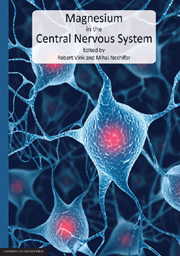Book contents
- Frontmatter
- List of Contributors
- Preface
- Contents
- Section 1 Magnesium in Normal Brain
- Section 2 Magnesium in Neurological Diseases
- Chapter 7 The role of magnesium therapy in learning and memory
- Chapter 8 The role of magnesium in headache and migraine
- Chapter 9 Magnesium in edema and blood-brain barrier disruption
- Chapter 10 Magnesium and hearing loss
- Chapter 11 The role of magnesium in pain
- Chapter 12 The role of magnesium in traumatic CNS injury
- Chapter 13 The use of magnesium in experimental cerebral ischaemia
- Chapter 14 Magnesium in subarachnoid hemorrhage
- Chapter 15 Magnesium in clinical stroke
- Chapter 16 Magnesium in cancer: more questions than answers
- Chapter 17 Magnesium in Parkinson's disease: an update in clinical and basic aspects
- Section 3 Involvement of Magnesium in Psychiatric Diseases
Chapter 14 - Magnesium in subarachnoid hemorrhage
from Section 2 - Magnesium in Neurological Diseases
Published online by Cambridge University Press: 05 June 2012
- Frontmatter
- List of Contributors
- Preface
- Contents
- Section 1 Magnesium in Normal Brain
- Section 2 Magnesium in Neurological Diseases
- Chapter 7 The role of magnesium therapy in learning and memory
- Chapter 8 The role of magnesium in headache and migraine
- Chapter 9 Magnesium in edema and blood-brain barrier disruption
- Chapter 10 Magnesium and hearing loss
- Chapter 11 The role of magnesium in pain
- Chapter 12 The role of magnesium in traumatic CNS injury
- Chapter 13 The use of magnesium in experimental cerebral ischaemia
- Chapter 14 Magnesium in subarachnoid hemorrhage
- Chapter 15 Magnesium in clinical stroke
- Chapter 16 Magnesium in cancer: more questions than answers
- Chapter 17 Magnesium in Parkinson's disease: an update in clinical and basic aspects
- Section 3 Involvement of Magnesium in Psychiatric Diseases
Summary
Abstract
Subarachnoid hemorrhage caused by a ruptured aneurysm accounts for only 5% of strokes, but occurs at a fairly young age and carries a worse prognosis. Delayed cerebral ischemia is an important cause of death and dependence after aneurysmal SAH. The current mainstay of preventing delayed cerebral ischemia is nimodipine and maintenance of normovolemia, but even with this strategy delayed cerebral ischemia occurs in a considerable proportion of patients. Magnesium is an inexpensive, easily available neuroprotective agent that reduces cerebral vasospasm and infarct volume after experimental subarachnoid hemorrhage. In a meta-analysis of all randomized clinical trials, magnesium shows a tendency to reduce the occurrence of delayed cerebral ischemia and poor outcome after subarachnoid hemorrhage, but the question if magnesium is advantageous in subarachnoid hemorrhage patients is still in abeyance. Currently a large phase III trial aiming for 1200 patients is being conducted that will hopefully provide definite evidence whether magnesium treatment is beneficial in subarachnoid hemorrhage patients.
Subarachnoid hemorrhage
Subarachnoid hemorrhage (SAH) caused by a ruptured aneurysm accounts for only 5% of strokes, but occurs at a fairly young age and carries a worse prognosis than other types of stroke (van Gijn et al, 2007). The cardinal feature is a history of unusually severe headache that started suddenly, but patients frequent deteriorate into unconsciousness shortly after onset.
- Type
- Chapter
- Information
- Magnesium in the Central Nervous System , pp. 193 - 204Publisher: The University of Adelaide PressPrint publication year: 2011
- 1
- Cited by

